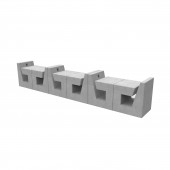B-Shape Concrete Public Seating by Product Design R&D Center of SWJTU |
Home > Winners > #43211 |
 |
|
||||
| DESIGN DETAILS | |||||
| DESIGN NAME: B-Shape Concrete PRIMARY FUNCTION: Public Seating INSPIRATION: Recovery of architectural waste is the big problem of environment protection. Waste architectural waste generally adopts the handling method of burying and piling, especially in developing countries. Designing and manufacturing public facilities whose materials are regenerative concrete can not only save the transportation expense of aggregate, but also save the land expenses occupied by architectural waste. UNIQUE PROPERTIES / PROJECT DESCRIPTION: This works takes the concrete waste as the aggregate of precast concrete to make concrete outdoor facilities, which enables new urban furniture to have ecological features. It adopts modular elements in model to provide the possibility of multiple display. It can be regarded as both a seat and a table. The installation of QR code enables the seat to have the function of location and multi-information service, which is characteristic of information society. OPERATION / FLOW / INTERACTION: Regard waste concrete as the aggregate of prefabricated concrete and make concrete outdoor facilities. Through revolving and displaying, it can be arranged into different combination modes, like seats, tables with seats, so as to suit different environments. PROJECT DURATION AND LOCATION: Completion Time:06,2015 Exhibition Place: Gallery Square of Southwest jiaotong University FITS BEST INTO CATEGORY: Social Design |
PRODUCTION / REALIZATION TECHNOLOGY: Shatter the architecture waste of concrete and prefabricate it into aggregate. Then proportion it to raw materials. Make mould and make concrete public facilities. 2-D barcodes is use for information spread of map/region culture. SPECIFICATIONS / TECHNICAL PROPERTIES: specifications: combinable. product dimensions: 500mm*420mm*550mm. package: without package. technical: by mold. TAGS: b-shape, renewable concrete, public seat, architectural waste, table RESEARCH ABSTRACT: With the increasingly quickening of urbanization process, the demand of concrete, the main material foundation of urbanization, also increases rapidly, especially in developing countries. On the other hand, recovery of architectural waste is the big problem of environment protection.Waste architectural waste generally adopts the handling method of burying and piling, which leads to great burden of the environment. Public furniture of regenerative concrete expands the application scope of regenerative concrete. CHALLENGE: The point lie in both the composition proportion of regenerative concrete. We have attempted many types and failed for many times. Finally we found appropriate proportion and mastered matching techniques. ADDED DATE: 2015-09-30 07:53:46 TEAM MEMBERS (5) : Professor: Huang Tao, Designer: Luo Xin, Designer: Zhao Xianan, Designer: Qiu Liwei and Designer: Wei Guangchao IMAGE CREDITS: Image #1: Photographer Luo Xin, 2015. Image #2: Designer Luo Xin, 2015. Image #3: Designer Luo Xin, 2015. Image #4: Designer Luo Xin, 2015. Image #5: Designer Luo Xin, 2015. |
||||
| Visit the following page to learn more: http://bit.ly/1JBPcLy | |||||
| AWARD DETAILS | |
 |
B-Shape Concrete Public Seating by Product Design R&d Center of Swjtu is Winner in Social Design Category, 2015 - 2016.· Read the interview with designer Product Design R&D Center of SWJTU for design B-Shape Concrete here.· Press Members: Login or Register to request an exclusive interview with Product Design R&D Center of SWJTU. · Click here to register inorder to view the profile and other works by Product Design R&D Center of SWJTU. |
| SOCIAL |
| + Add to Likes / Favorites | Send to My Email | Comment | Testimonials | View Press-Release | Press Kit |
Did you like Product Design R&d Center of Swjtu's Social Design?
You will most likely enjoy other award winning social design as well.
Click here to view more Award Winning Social Design.








